Business Organisations and Environments: Nike in Switzerland
VerifiedAdded on 2020/10/05
|11
|3611
|327
Report
AI Summary
This report examines Nike's business strategy within the context of its planned expansion into Switzerland. It begins with an introduction outlining the importance of environmental analysis for business success, particularly in a global context. The main body of the report comprises a PESTLE analysis of Switzerland, evaluating political, economic, social, technological, legal, and environmental factors and their implications for Nike. This includes an assessment of Switzerland's political stability, economic freedom, social demographics, technological advancements, legal framework, and environmental regulations. Following the PESTLE analysis, the report applies Porter's Five Forces model to assess the competitive landscape for Nike in Switzerland, evaluating factors such as the threat of new entrants, bargaining power of suppliers and buyers, the threat of substitute products or services, and the intensity of competitive rivalry. The report concludes by summarizing the key findings and implications for Nike's strategic decision-making as it expands its business operations in Switzerland.
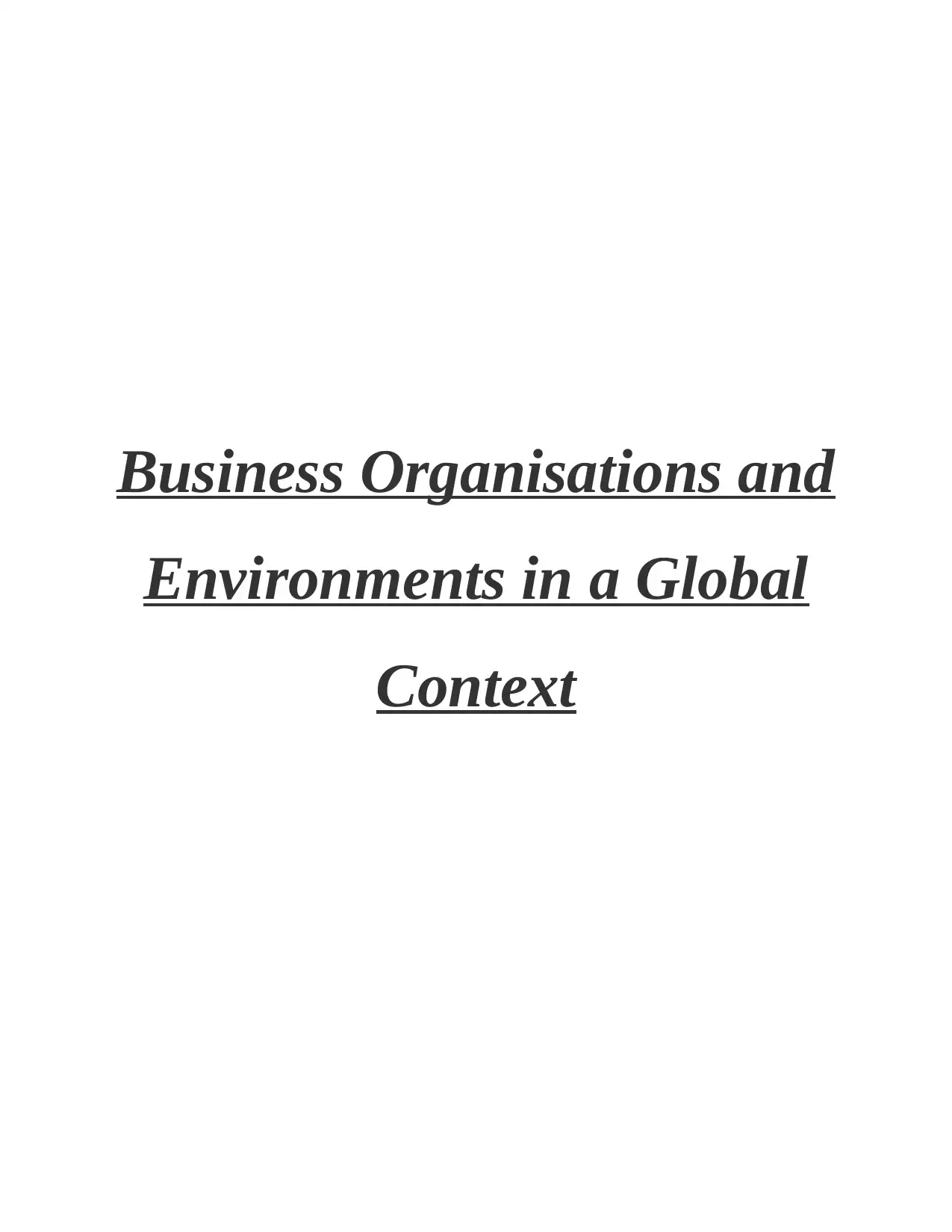
Business Organisations and
Environments in a Global
Context
Environments in a Global
Context
Paraphrase This Document
Need a fresh take? Get an instant paraphrase of this document with our AI Paraphraser
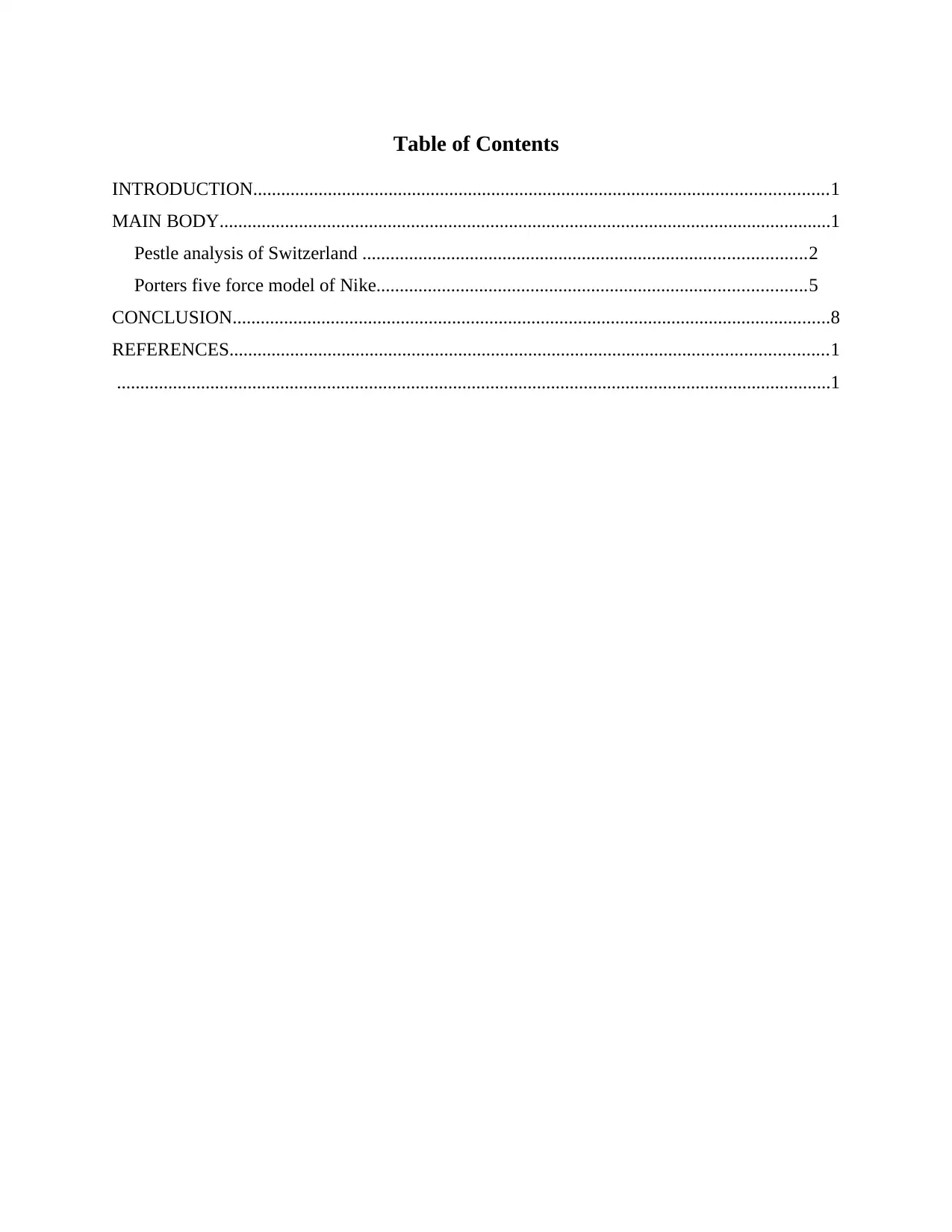
Table of Contents
INTRODUCTION...........................................................................................................................1
MAIN BODY...................................................................................................................................1
Pestle analysis of Switzerland ...............................................................................................2
Porters five force model of Nike............................................................................................5
CONCLUSION................................................................................................................................8
REFERENCES................................................................................................................................1
.........................................................................................................................................................1
INTRODUCTION...........................................................................................................................1
MAIN BODY...................................................................................................................................1
Pestle analysis of Switzerland ...............................................................................................2
Porters five force model of Nike............................................................................................5
CONCLUSION................................................................................................................................8
REFERENCES................................................................................................................................1
.........................................................................................................................................................1
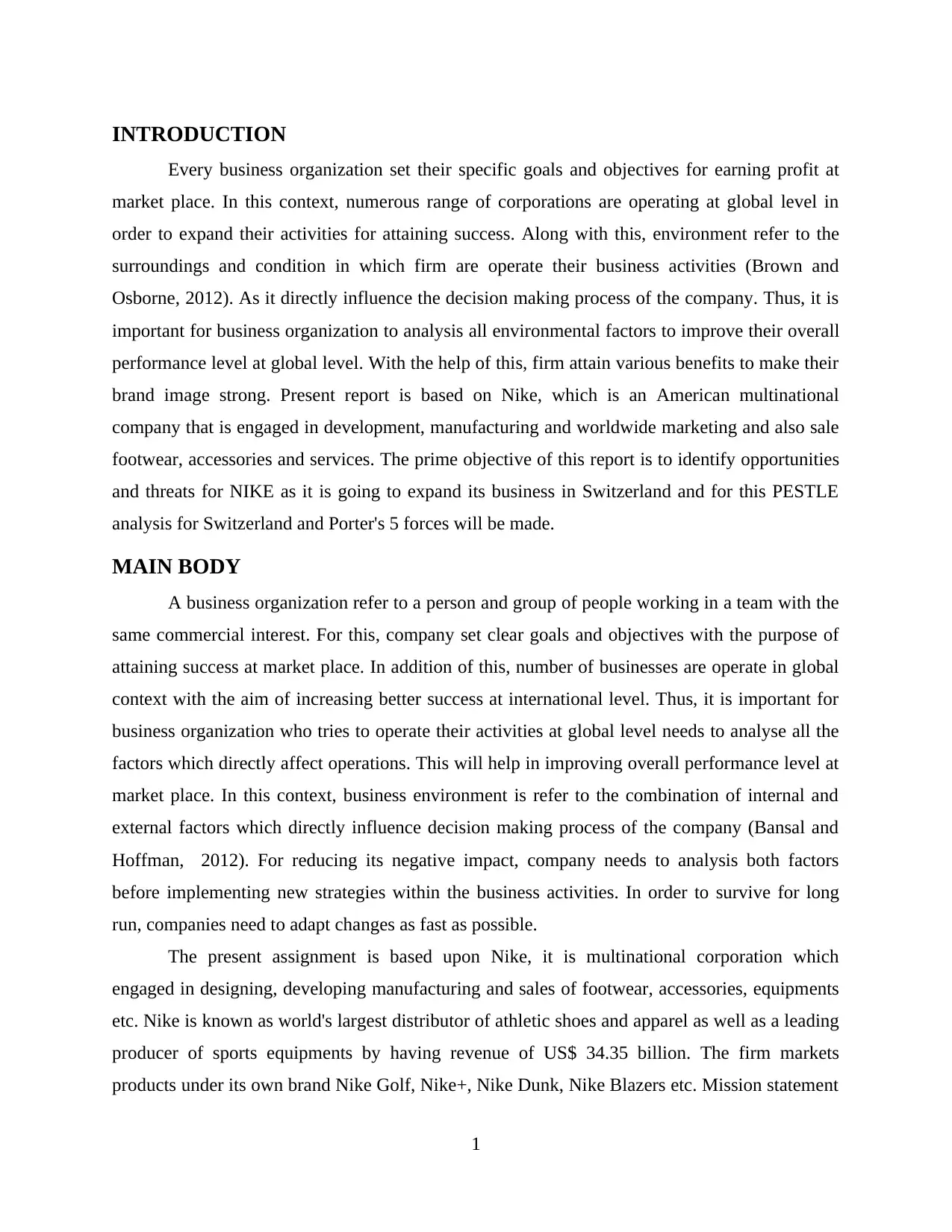
INTRODUCTION
Every business organization set their specific goals and objectives for earning profit at
market place. In this context, numerous range of corporations are operating at global level in
order to expand their activities for attaining success. Along with this, environment refer to the
surroundings and condition in which firm are operate their business activities (Brown and
Osborne, 2012). As it directly influence the decision making process of the company. Thus, it is
important for business organization to analysis all environmental factors to improve their overall
performance level at global level. With the help of this, firm attain various benefits to make their
brand image strong. Present report is based on Nike, which is an American multinational
company that is engaged in development, manufacturing and worldwide marketing and also sale
footwear, accessories and services. The prime objective of this report is to identify opportunities
and threats for NIKE as it is going to expand its business in Switzerland and for this PESTLE
analysis for Switzerland and Porter's 5 forces will be made.
MAIN BODY
A business organization refer to a person and group of people working in a team with the
same commercial interest. For this, company set clear goals and objectives with the purpose of
attaining success at market place. In addition of this, number of businesses are operate in global
context with the aim of increasing better success at international level. Thus, it is important for
business organization who tries to operate their activities at global level needs to analyse all the
factors which directly affect operations. This will help in improving overall performance level at
market place. In this context, business environment is refer to the combination of internal and
external factors which directly influence decision making process of the company (Bansal and
Hoffman, 2012). For reducing its negative impact, company needs to analysis both factors
before implementing new strategies within the business activities. In order to survive for long
run, companies need to adapt changes as fast as possible.
The present assignment is based upon Nike, it is multinational corporation which
engaged in designing, developing manufacturing and sales of footwear, accessories, equipments
etc. Nike is known as world's largest distributor of athletic shoes and apparel as well as a leading
producer of sports equipments by having revenue of US$ 34.35 billion. The firm markets
products under its own brand Nike Golf, Nike+, Nike Dunk, Nike Blazers etc. Mission statement
1
Every business organization set their specific goals and objectives for earning profit at
market place. In this context, numerous range of corporations are operating at global level in
order to expand their activities for attaining success. Along with this, environment refer to the
surroundings and condition in which firm are operate their business activities (Brown and
Osborne, 2012). As it directly influence the decision making process of the company. Thus, it is
important for business organization to analysis all environmental factors to improve their overall
performance level at global level. With the help of this, firm attain various benefits to make their
brand image strong. Present report is based on Nike, which is an American multinational
company that is engaged in development, manufacturing and worldwide marketing and also sale
footwear, accessories and services. The prime objective of this report is to identify opportunities
and threats for NIKE as it is going to expand its business in Switzerland and for this PESTLE
analysis for Switzerland and Porter's 5 forces will be made.
MAIN BODY
A business organization refer to a person and group of people working in a team with the
same commercial interest. For this, company set clear goals and objectives with the purpose of
attaining success at market place. In addition of this, number of businesses are operate in global
context with the aim of increasing better success at international level. Thus, it is important for
business organization who tries to operate their activities at global level needs to analyse all the
factors which directly affect operations. This will help in improving overall performance level at
market place. In this context, business environment is refer to the combination of internal and
external factors which directly influence decision making process of the company (Bansal and
Hoffman, 2012). For reducing its negative impact, company needs to analysis both factors
before implementing new strategies within the business activities. In order to survive for long
run, companies need to adapt changes as fast as possible.
The present assignment is based upon Nike, it is multinational corporation which
engaged in designing, developing manufacturing and sales of footwear, accessories, equipments
etc. Nike is known as world's largest distributor of athletic shoes and apparel as well as a leading
producer of sports equipments by having revenue of US$ 34.35 billion. The firm markets
products under its own brand Nike Golf, Nike+, Nike Dunk, Nike Blazers etc. Mission statement
1
⊘ This is a preview!⊘
Do you want full access?
Subscribe today to unlock all pages.

Trusted by 1+ million students worldwide
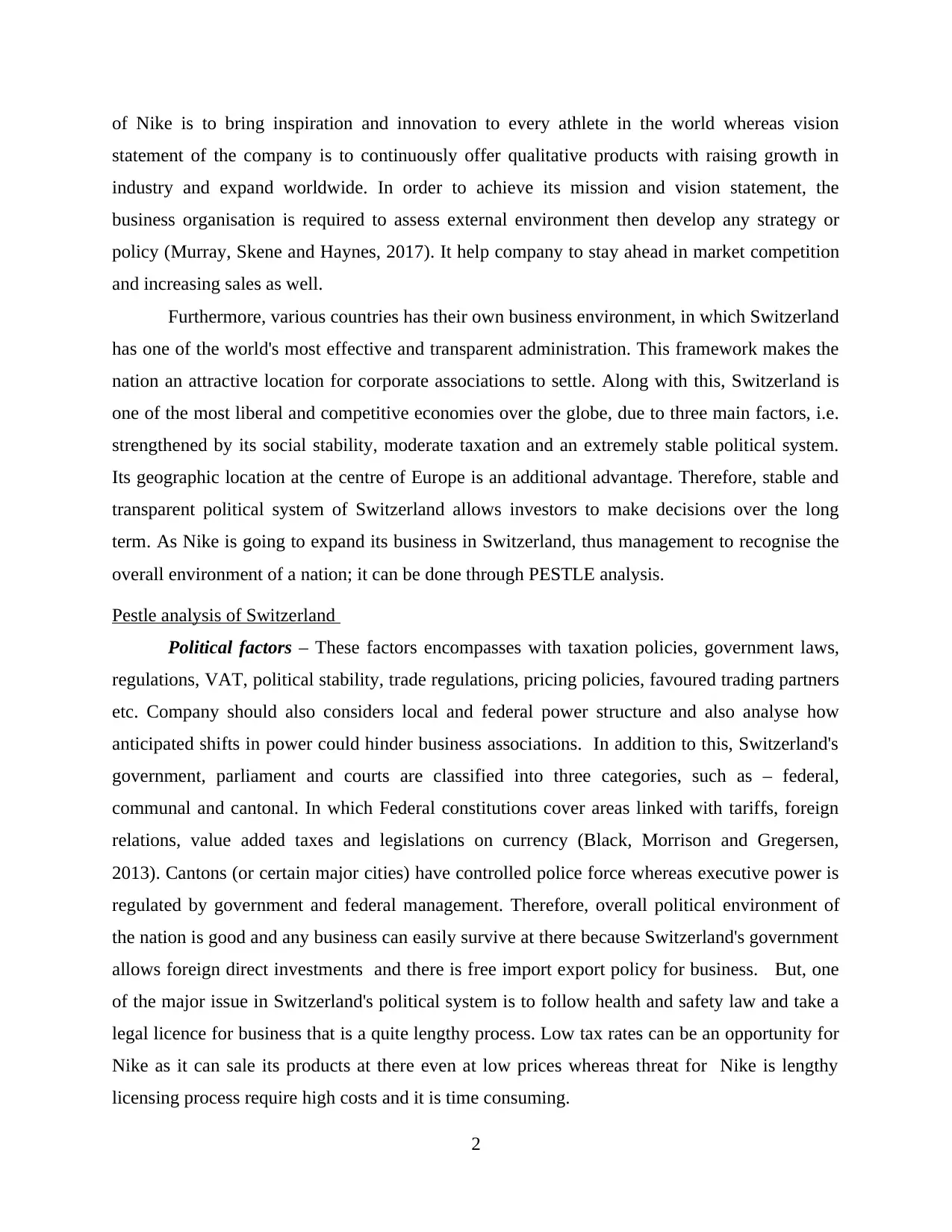
of Nike is to bring inspiration and innovation to every athlete in the world whereas vision
statement of the company is to continuously offer qualitative products with raising growth in
industry and expand worldwide. In order to achieve its mission and vision statement, the
business organisation is required to assess external environment then develop any strategy or
policy (Murray, Skene and Haynes, 2017). It help company to stay ahead in market competition
and increasing sales as well.
Furthermore, various countries has their own business environment, in which Switzerland
has one of the world's most effective and transparent administration. This framework makes the
nation an attractive location for corporate associations to settle. Along with this, Switzerland is
one of the most liberal and competitive economies over the globe, due to three main factors, i.e.
strengthened by its social stability, moderate taxation and an extremely stable political system.
Its geographic location at the centre of Europe is an additional advantage. Therefore, stable and
transparent political system of Switzerland allows investors to make decisions over the long
term. As Nike is going to expand its business in Switzerland, thus management to recognise the
overall environment of a nation; it can be done through PESTLE analysis.
Pestle analysis of Switzerland
Political factors – These factors encompasses with taxation policies, government laws,
regulations, VAT, political stability, trade regulations, pricing policies, favoured trading partners
etc. Company should also considers local and federal power structure and also analyse how
anticipated shifts in power could hinder business associations. In addition to this, Switzerland's
government, parliament and courts are classified into three categories, such as – federal,
communal and cantonal. In which Federal constitutions cover areas linked with tariffs, foreign
relations, value added taxes and legislations on currency (Black, Morrison and Gregersen,
2013). Cantons (or certain major cities) have controlled police force whereas executive power is
regulated by government and federal management. Therefore, overall political environment of
the nation is good and any business can easily survive at there because Switzerland's government
allows foreign direct investments and there is free import export policy for business. But, one
of the major issue in Switzerland's political system is to follow health and safety law and take a
legal licence for business that is a quite lengthy process. Low tax rates can be an opportunity for
Nike as it can sale its products at there even at low prices whereas threat for Nike is lengthy
licensing process require high costs and it is time consuming.
2
statement of the company is to continuously offer qualitative products with raising growth in
industry and expand worldwide. In order to achieve its mission and vision statement, the
business organisation is required to assess external environment then develop any strategy or
policy (Murray, Skene and Haynes, 2017). It help company to stay ahead in market competition
and increasing sales as well.
Furthermore, various countries has their own business environment, in which Switzerland
has one of the world's most effective and transparent administration. This framework makes the
nation an attractive location for corporate associations to settle. Along with this, Switzerland is
one of the most liberal and competitive economies over the globe, due to three main factors, i.e.
strengthened by its social stability, moderate taxation and an extremely stable political system.
Its geographic location at the centre of Europe is an additional advantage. Therefore, stable and
transparent political system of Switzerland allows investors to make decisions over the long
term. As Nike is going to expand its business in Switzerland, thus management to recognise the
overall environment of a nation; it can be done through PESTLE analysis.
Pestle analysis of Switzerland
Political factors – These factors encompasses with taxation policies, government laws,
regulations, VAT, political stability, trade regulations, pricing policies, favoured trading partners
etc. Company should also considers local and federal power structure and also analyse how
anticipated shifts in power could hinder business associations. In addition to this, Switzerland's
government, parliament and courts are classified into three categories, such as – federal,
communal and cantonal. In which Federal constitutions cover areas linked with tariffs, foreign
relations, value added taxes and legislations on currency (Black, Morrison and Gregersen,
2013). Cantons (or certain major cities) have controlled police force whereas executive power is
regulated by government and federal management. Therefore, overall political environment of
the nation is good and any business can easily survive at there because Switzerland's government
allows foreign direct investments and there is free import export policy for business. But, one
of the major issue in Switzerland's political system is to follow health and safety law and take a
legal licence for business that is a quite lengthy process. Low tax rates can be an opportunity for
Nike as it can sale its products at there even at low prices whereas threat for Nike is lengthy
licensing process require high costs and it is time consuming.
2
Paraphrase This Document
Need a fresh take? Get an instant paraphrase of this document with our AI Paraphraser
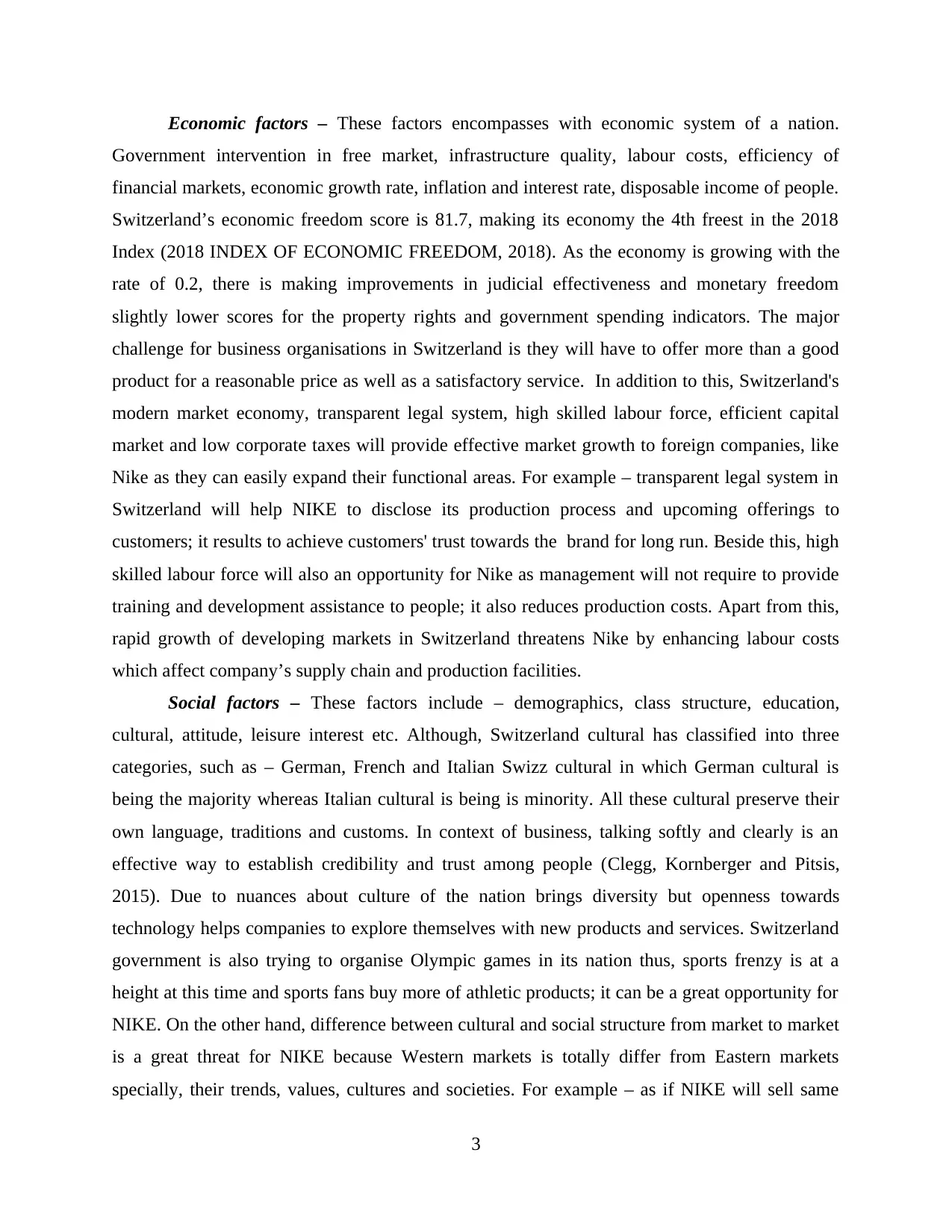
Economic factors – These factors encompasses with economic system of a nation.
Government intervention in free market, infrastructure quality, labour costs, efficiency of
financial markets, economic growth rate, inflation and interest rate, disposable income of people.
Switzerland’s economic freedom score is 81.7, making its economy the 4th freest in the 2018
Index (2018 INDEX OF ECONOMIC FREEDOM, 2018). As the economy is growing with the
rate of 0.2, there is making improvements in judicial effectiveness and monetary freedom
slightly lower scores for the property rights and government spending indicators. The major
challenge for business organisations in Switzerland is they will have to offer more than a good
product for a reasonable price as well as a satisfactory service. In addition to this, Switzerland's
modern market economy, transparent legal system, high skilled labour force, efficient capital
market and low corporate taxes will provide effective market growth to foreign companies, like
Nike as they can easily expand their functional areas. For example – transparent legal system in
Switzerland will help NIKE to disclose its production process and upcoming offerings to
customers; it results to achieve customers' trust towards the brand for long run. Beside this, high
skilled labour force will also an opportunity for Nike as management will not require to provide
training and development assistance to people; it also reduces production costs. Apart from this,
rapid growth of developing markets in Switzerland threatens Nike by enhancing labour costs
which affect company’s supply chain and production facilities.
Social factors – These factors include – demographics, class structure, education,
cultural, attitude, leisure interest etc. Although, Switzerland cultural has classified into three
categories, such as – German, French and Italian Swizz cultural in which German cultural is
being the majority whereas Italian cultural is being is minority. All these cultural preserve their
own language, traditions and customs. In context of business, talking softly and clearly is an
effective way to establish credibility and trust among people (Clegg, Kornberger and Pitsis,
2015). Due to nuances about culture of the nation brings diversity but openness towards
technology helps companies to explore themselves with new products and services. Switzerland
government is also trying to organise Olympic games in its nation thus, sports frenzy is at a
height at this time and sports fans buy more of athletic products; it can be a great opportunity for
NIKE. On the other hand, difference between cultural and social structure from market to market
is a great threat for NIKE because Western markets is totally differ from Eastern markets
specially, their trends, values, cultures and societies. For example – as if NIKE will sell same
3
Government intervention in free market, infrastructure quality, labour costs, efficiency of
financial markets, economic growth rate, inflation and interest rate, disposable income of people.
Switzerland’s economic freedom score is 81.7, making its economy the 4th freest in the 2018
Index (2018 INDEX OF ECONOMIC FREEDOM, 2018). As the economy is growing with the
rate of 0.2, there is making improvements in judicial effectiveness and monetary freedom
slightly lower scores for the property rights and government spending indicators. The major
challenge for business organisations in Switzerland is they will have to offer more than a good
product for a reasonable price as well as a satisfactory service. In addition to this, Switzerland's
modern market economy, transparent legal system, high skilled labour force, efficient capital
market and low corporate taxes will provide effective market growth to foreign companies, like
Nike as they can easily expand their functional areas. For example – transparent legal system in
Switzerland will help NIKE to disclose its production process and upcoming offerings to
customers; it results to achieve customers' trust towards the brand for long run. Beside this, high
skilled labour force will also an opportunity for Nike as management will not require to provide
training and development assistance to people; it also reduces production costs. Apart from this,
rapid growth of developing markets in Switzerland threatens Nike by enhancing labour costs
which affect company’s supply chain and production facilities.
Social factors – These factors include – demographics, class structure, education,
cultural, attitude, leisure interest etc. Although, Switzerland cultural has classified into three
categories, such as – German, French and Italian Swizz cultural in which German cultural is
being the majority whereas Italian cultural is being is minority. All these cultural preserve their
own language, traditions and customs. In context of business, talking softly and clearly is an
effective way to establish credibility and trust among people (Clegg, Kornberger and Pitsis,
2015). Due to nuances about culture of the nation brings diversity but openness towards
technology helps companies to explore themselves with new products and services. Switzerland
government is also trying to organise Olympic games in its nation thus, sports frenzy is at a
height at this time and sports fans buy more of athletic products; it can be a great opportunity for
NIKE. On the other hand, difference between cultural and social structure from market to market
is a great threat for NIKE because Western markets is totally differ from Eastern markets
specially, their trends, values, cultures and societies. For example – as if NIKE will sell same
3
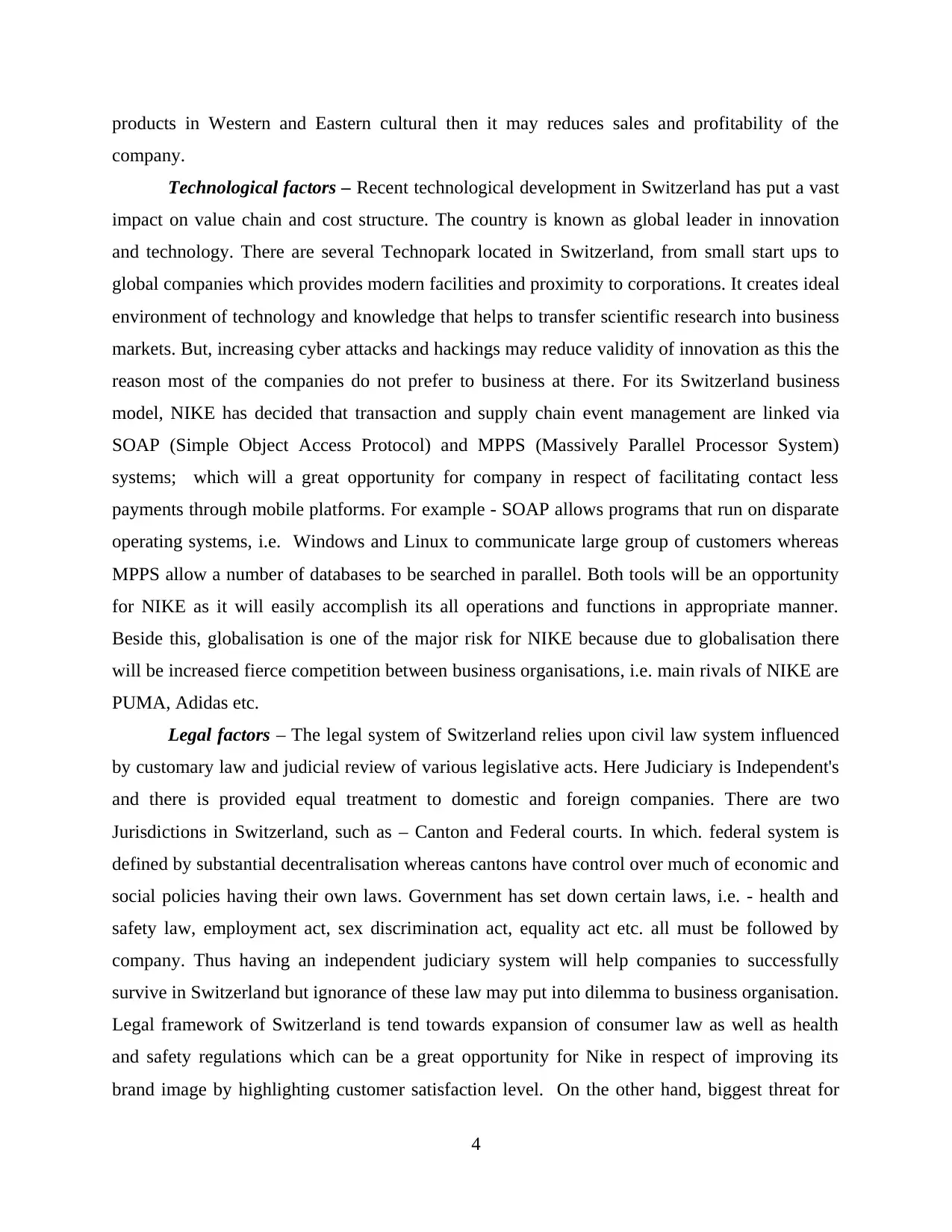
products in Western and Eastern cultural then it may reduces sales and profitability of the
company.
Technological factors – Recent technological development in Switzerland has put a vast
impact on value chain and cost structure. The country is known as global leader in innovation
and technology. There are several Technopark located in Switzerland, from small start ups to
global companies which provides modern facilities and proximity to corporations. It creates ideal
environment of technology and knowledge that helps to transfer scientific research into business
markets. But, increasing cyber attacks and hackings may reduce validity of innovation as this the
reason most of the companies do not prefer to business at there. For its Switzerland business
model, NIKE has decided that transaction and supply chain event management are linked via
SOAP (Simple Object Access Protocol) and MPPS (Massively Parallel Processor System)
systems; which will a great opportunity for company in respect of facilitating contact less
payments through mobile platforms. For example - SOAP allows programs that run on disparate
operating systems, i.e. Windows and Linux to communicate large group of customers whereas
MPPS allow a number of databases to be searched in parallel. Both tools will be an opportunity
for NIKE as it will easily accomplish its all operations and functions in appropriate manner.
Beside this, globalisation is one of the major risk for NIKE because due to globalisation there
will be increased fierce competition between business organisations, i.e. main rivals of NIKE are
PUMA, Adidas etc.
Legal factors – The legal system of Switzerland relies upon civil law system influenced
by customary law and judicial review of various legislative acts. Here Judiciary is Independent's
and there is provided equal treatment to domestic and foreign companies. There are two
Jurisdictions in Switzerland, such as – Canton and Federal courts. In which. federal system is
defined by substantial decentralisation whereas cantons have control over much of economic and
social policies having their own laws. Government has set down certain laws, i.e. - health and
safety law, employment act, sex discrimination act, equality act etc. all must be followed by
company. Thus having an independent judiciary system will help companies to successfully
survive in Switzerland but ignorance of these law may put into dilemma to business organisation.
Legal framework of Switzerland is tend towards expansion of consumer law as well as health
and safety regulations which can be a great opportunity for Nike in respect of improving its
brand image by highlighting customer satisfaction level. On the other hand, biggest threat for
4
company.
Technological factors – Recent technological development in Switzerland has put a vast
impact on value chain and cost structure. The country is known as global leader in innovation
and technology. There are several Technopark located in Switzerland, from small start ups to
global companies which provides modern facilities and proximity to corporations. It creates ideal
environment of technology and knowledge that helps to transfer scientific research into business
markets. But, increasing cyber attacks and hackings may reduce validity of innovation as this the
reason most of the companies do not prefer to business at there. For its Switzerland business
model, NIKE has decided that transaction and supply chain event management are linked via
SOAP (Simple Object Access Protocol) and MPPS (Massively Parallel Processor System)
systems; which will a great opportunity for company in respect of facilitating contact less
payments through mobile platforms. For example - SOAP allows programs that run on disparate
operating systems, i.e. Windows and Linux to communicate large group of customers whereas
MPPS allow a number of databases to be searched in parallel. Both tools will be an opportunity
for NIKE as it will easily accomplish its all operations and functions in appropriate manner.
Beside this, globalisation is one of the major risk for NIKE because due to globalisation there
will be increased fierce competition between business organisations, i.e. main rivals of NIKE are
PUMA, Adidas etc.
Legal factors – The legal system of Switzerland relies upon civil law system influenced
by customary law and judicial review of various legislative acts. Here Judiciary is Independent's
and there is provided equal treatment to domestic and foreign companies. There are two
Jurisdictions in Switzerland, such as – Canton and Federal courts. In which. federal system is
defined by substantial decentralisation whereas cantons have control over much of economic and
social policies having their own laws. Government has set down certain laws, i.e. - health and
safety law, employment act, sex discrimination act, equality act etc. all must be followed by
company. Thus having an independent judiciary system will help companies to successfully
survive in Switzerland but ignorance of these law may put into dilemma to business organisation.
Legal framework of Switzerland is tend towards expansion of consumer law as well as health
and safety regulations which can be a great opportunity for Nike in respect of improving its
brand image by highlighting customer satisfaction level. On the other hand, biggest threat for
4
⊘ This is a preview!⊘
Do you want full access?
Subscribe today to unlock all pages.

Trusted by 1+ million students worldwide
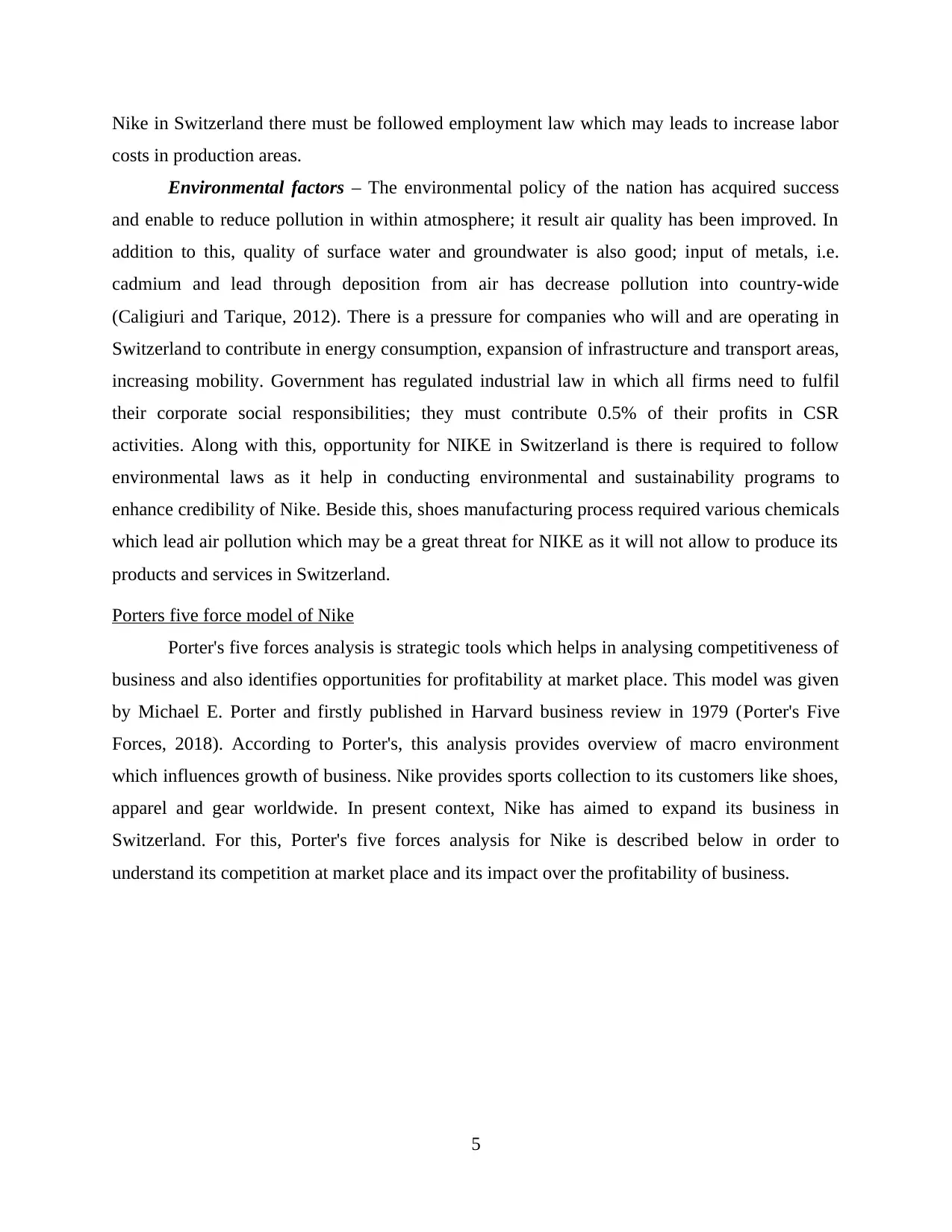
Nike in Switzerland there must be followed employment law which may leads to increase labor
costs in production areas.
Environmental factors – The environmental policy of the nation has acquired success
and enable to reduce pollution in within atmosphere; it result air quality has been improved. In
addition to this, quality of surface water and groundwater is also good; input of metals, i.e.
cadmium and lead through deposition from air has decrease pollution into country-wide
(Caligiuri and Tarique, 2012). There is a pressure for companies who will and are operating in
Switzerland to contribute in energy consumption, expansion of infrastructure and transport areas,
increasing mobility. Government has regulated industrial law in which all firms need to fulfil
their corporate social responsibilities; they must contribute 0.5% of their profits in CSR
activities. Along with this, opportunity for NIKE in Switzerland is there is required to follow
environmental laws as it help in conducting environmental and sustainability programs to
enhance credibility of Nike. Beside this, shoes manufacturing process required various chemicals
which lead air pollution which may be a great threat for NIKE as it will not allow to produce its
products and services in Switzerland.
Porters five force model of Nike
Porter's five forces analysis is strategic tools which helps in analysing competitiveness of
business and also identifies opportunities for profitability at market place. This model was given
by Michael E. Porter and firstly published in Harvard business review in 1979 (Porter's Five
Forces, 2018). According to Porter's, this analysis provides overview of macro environment
which influences growth of business. Nike provides sports collection to its customers like shoes,
apparel and gear worldwide. In present context, Nike has aimed to expand its business in
Switzerland. For this, Porter's five forces analysis for Nike is described below in order to
understand its competition at market place and its impact over the profitability of business.
5
costs in production areas.
Environmental factors – The environmental policy of the nation has acquired success
and enable to reduce pollution in within atmosphere; it result air quality has been improved. In
addition to this, quality of surface water and groundwater is also good; input of metals, i.e.
cadmium and lead through deposition from air has decrease pollution into country-wide
(Caligiuri and Tarique, 2012). There is a pressure for companies who will and are operating in
Switzerland to contribute in energy consumption, expansion of infrastructure and transport areas,
increasing mobility. Government has regulated industrial law in which all firms need to fulfil
their corporate social responsibilities; they must contribute 0.5% of their profits in CSR
activities. Along with this, opportunity for NIKE in Switzerland is there is required to follow
environmental laws as it help in conducting environmental and sustainability programs to
enhance credibility of Nike. Beside this, shoes manufacturing process required various chemicals
which lead air pollution which may be a great threat for NIKE as it will not allow to produce its
products and services in Switzerland.
Porters five force model of Nike
Porter's five forces analysis is strategic tools which helps in analysing competitiveness of
business and also identifies opportunities for profitability at market place. This model was given
by Michael E. Porter and firstly published in Harvard business review in 1979 (Porter's Five
Forces, 2018). According to Porter's, this analysis provides overview of macro environment
which influences growth of business. Nike provides sports collection to its customers like shoes,
apparel and gear worldwide. In present context, Nike has aimed to expand its business in
Switzerland. For this, Porter's five forces analysis for Nike is described below in order to
understand its competition at market place and its impact over the profitability of business.
5
Paraphrase This Document
Need a fresh take? Get an instant paraphrase of this document with our AI Paraphraser
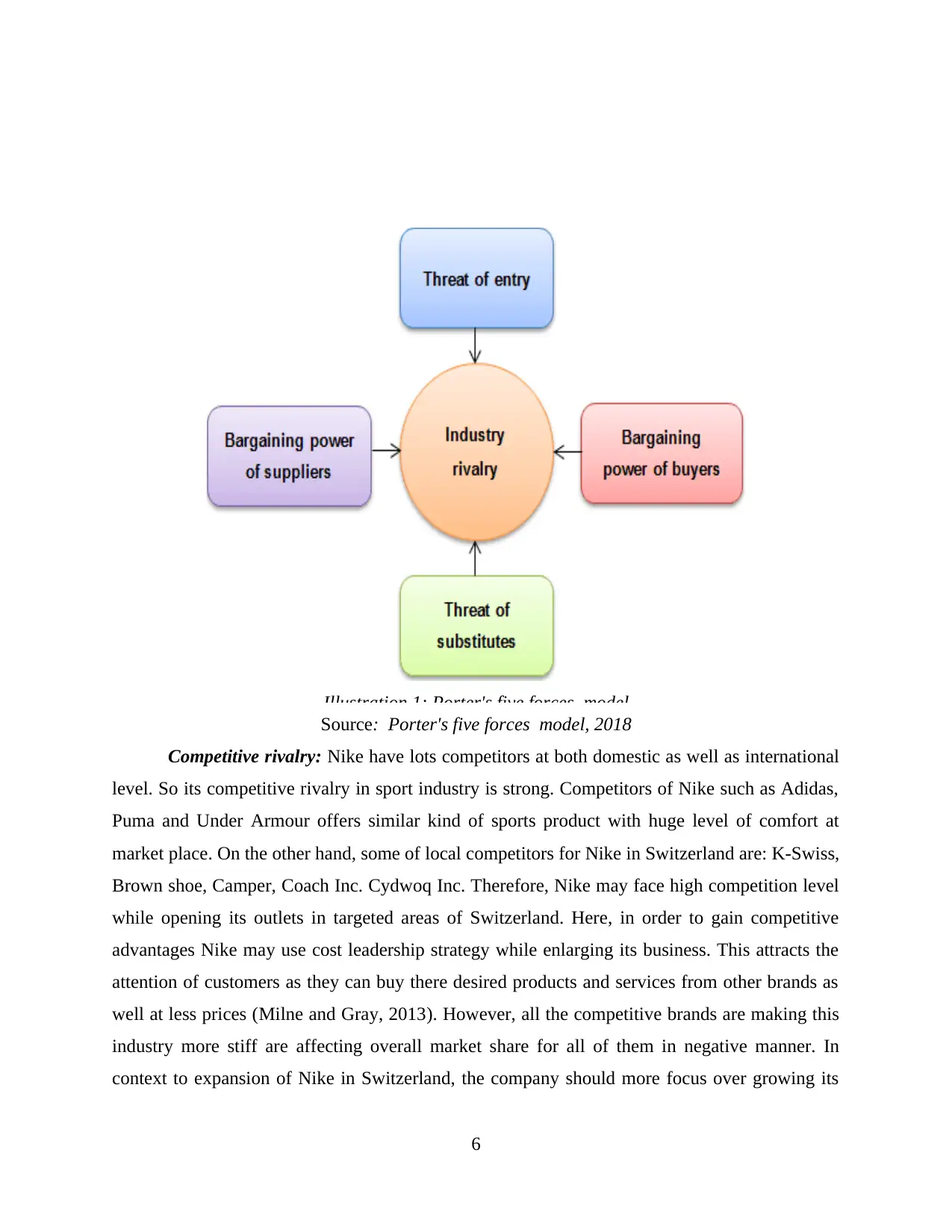
Source: Porter's five forces model, 2018
Competitive rivalry: Nike have lots competitors at both domestic as well as international
level. So its competitive rivalry in sport industry is strong. Competitors of Nike such as Adidas,
Puma and Under Armour offers similar kind of sports product with huge level of comfort at
market place. On the other hand, some of local competitors for Nike in Switzerland are: K-Swiss,
Brown shoe, Camper, Coach Inc. Cydwoq Inc. Therefore, Nike may face high competition level
while opening its outlets in targeted areas of Switzerland. Here, in order to gain competitive
advantages Nike may use cost leadership strategy while enlarging its business. This attracts the
attention of customers as they can buy there desired products and services from other brands as
well at less prices (Milne and Gray, 2013). However, all the competitive brands are making this
industry more stiff are affecting overall market share for all of them in negative manner. In
context to expansion of Nike in Switzerland, the company should more focus over growing its
6
Illustration 1: Porter's five forces model
Competitive rivalry: Nike have lots competitors at both domestic as well as international
level. So its competitive rivalry in sport industry is strong. Competitors of Nike such as Adidas,
Puma and Under Armour offers similar kind of sports product with huge level of comfort at
market place. On the other hand, some of local competitors for Nike in Switzerland are: K-Swiss,
Brown shoe, Camper, Coach Inc. Cydwoq Inc. Therefore, Nike may face high competition level
while opening its outlets in targeted areas of Switzerland. Here, in order to gain competitive
advantages Nike may use cost leadership strategy while enlarging its business. This attracts the
attention of customers as they can buy there desired products and services from other brands as
well at less prices (Milne and Gray, 2013). However, all the competitive brands are making this
industry more stiff are affecting overall market share for all of them in negative manner. In
context to expansion of Nike in Switzerland, the company should more focus over growing its
6
Illustration 1: Porter's five forces model
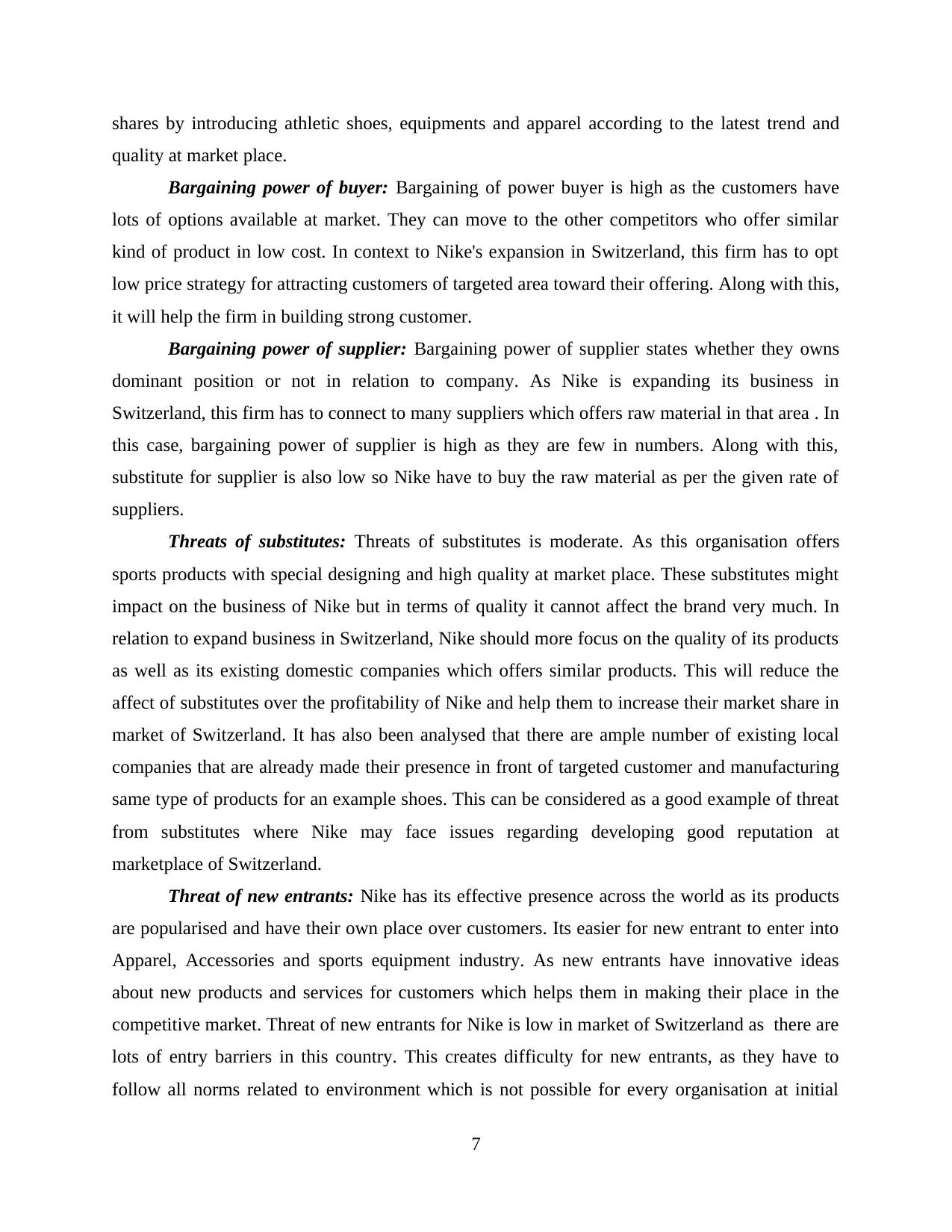
shares by introducing athletic shoes, equipments and apparel according to the latest trend and
quality at market place.
Bargaining power of buyer: Bargaining of power buyer is high as the customers have
lots of options available at market. They can move to the other competitors who offer similar
kind of product in low cost. In context to Nike's expansion in Switzerland, this firm has to opt
low price strategy for attracting customers of targeted area toward their offering. Along with this,
it will help the firm in building strong customer.
Bargaining power of supplier: Bargaining power of supplier states whether they owns
dominant position or not in relation to company. As Nike is expanding its business in
Switzerland, this firm has to connect to many suppliers which offers raw material in that area . In
this case, bargaining power of supplier is high as they are few in numbers. Along with this,
substitute for supplier is also low so Nike have to buy the raw material as per the given rate of
suppliers.
Threats of substitutes: Threats of substitutes is moderate. As this organisation offers
sports products with special designing and high quality at market place. These substitutes might
impact on the business of Nike but in terms of quality it cannot affect the brand very much. In
relation to expand business in Switzerland, Nike should more focus on the quality of its products
as well as its existing domestic companies which offers similar products. This will reduce the
affect of substitutes over the profitability of Nike and help them to increase their market share in
market of Switzerland. It has also been analysed that there are ample number of existing local
companies that are already made their presence in front of targeted customer and manufacturing
same type of products for an example shoes. This can be considered as a good example of threat
from substitutes where Nike may face issues regarding developing good reputation at
marketplace of Switzerland.
Threat of new entrants: Nike has its effective presence across the world as its products
are popularised and have their own place over customers. Its easier for new entrant to enter into
Apparel, Accessories and sports equipment industry. As new entrants have innovative ideas
about new products and services for customers which helps them in making their place in the
competitive market. Threat of new entrants for Nike is low in market of Switzerland as there are
lots of entry barriers in this country. This creates difficulty for new entrants, as they have to
follow all norms related to environment which is not possible for every organisation at initial
7
quality at market place.
Bargaining power of buyer: Bargaining of power buyer is high as the customers have
lots of options available at market. They can move to the other competitors who offer similar
kind of product in low cost. In context to Nike's expansion in Switzerland, this firm has to opt
low price strategy for attracting customers of targeted area toward their offering. Along with this,
it will help the firm in building strong customer.
Bargaining power of supplier: Bargaining power of supplier states whether they owns
dominant position or not in relation to company. As Nike is expanding its business in
Switzerland, this firm has to connect to many suppliers which offers raw material in that area . In
this case, bargaining power of supplier is high as they are few in numbers. Along with this,
substitute for supplier is also low so Nike have to buy the raw material as per the given rate of
suppliers.
Threats of substitutes: Threats of substitutes is moderate. As this organisation offers
sports products with special designing and high quality at market place. These substitutes might
impact on the business of Nike but in terms of quality it cannot affect the brand very much. In
relation to expand business in Switzerland, Nike should more focus on the quality of its products
as well as its existing domestic companies which offers similar products. This will reduce the
affect of substitutes over the profitability of Nike and help them to increase their market share in
market of Switzerland. It has also been analysed that there are ample number of existing local
companies that are already made their presence in front of targeted customer and manufacturing
same type of products for an example shoes. This can be considered as a good example of threat
from substitutes where Nike may face issues regarding developing good reputation at
marketplace of Switzerland.
Threat of new entrants: Nike has its effective presence across the world as its products
are popularised and have their own place over customers. Its easier for new entrant to enter into
Apparel, Accessories and sports equipment industry. As new entrants have innovative ideas
about new products and services for customers which helps them in making their place in the
competitive market. Threat of new entrants for Nike is low in market of Switzerland as there are
lots of entry barriers in this country. This creates difficulty for new entrants, as they have to
follow all norms related to environment which is not possible for every organisation at initial
7
⊘ This is a preview!⊘
Do you want full access?
Subscribe today to unlock all pages.

Trusted by 1+ million students worldwide
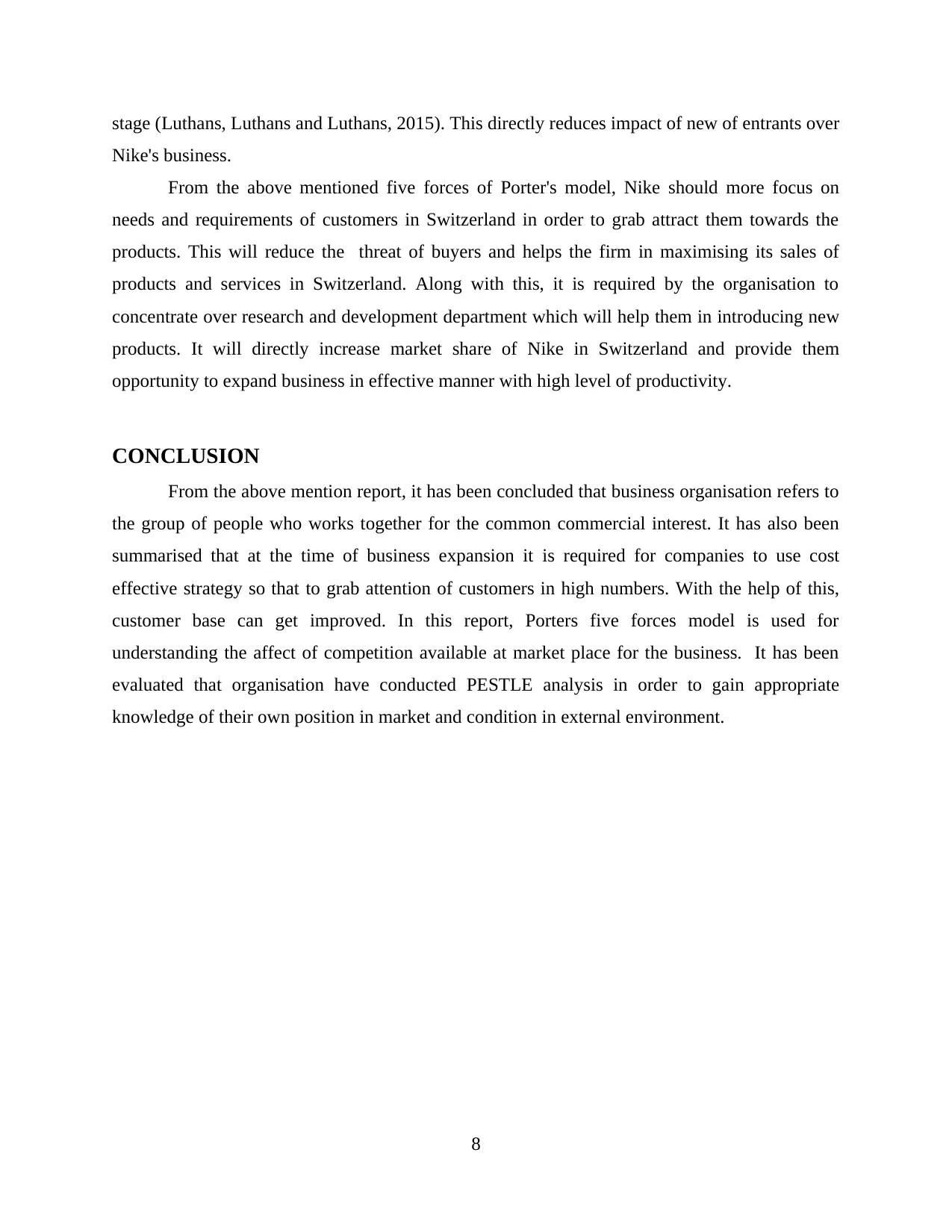
stage (Luthans, Luthans and Luthans, 2015). This directly reduces impact of new of entrants over
Nike's business.
From the above mentioned five forces of Porter's model, Nike should more focus on
needs and requirements of customers in Switzerland in order to grab attract them towards the
products. This will reduce the threat of buyers and helps the firm in maximising its sales of
products and services in Switzerland. Along with this, it is required by the organisation to
concentrate over research and development department which will help them in introducing new
products. It will directly increase market share of Nike in Switzerland and provide them
opportunity to expand business in effective manner with high level of productivity.
CONCLUSION
From the above mention report, it has been concluded that business organisation refers to
the group of people who works together for the common commercial interest. It has also been
summarised that at the time of business expansion it is required for companies to use cost
effective strategy so that to grab attention of customers in high numbers. With the help of this,
customer base can get improved. In this report, Porters five forces model is used for
understanding the affect of competition available at market place for the business. It has been
evaluated that organisation have conducted PESTLE analysis in order to gain appropriate
knowledge of their own position in market and condition in external environment.
8
Nike's business.
From the above mentioned five forces of Porter's model, Nike should more focus on
needs and requirements of customers in Switzerland in order to grab attract them towards the
products. This will reduce the threat of buyers and helps the firm in maximising its sales of
products and services in Switzerland. Along with this, it is required by the organisation to
concentrate over research and development department which will help them in introducing new
products. It will directly increase market share of Nike in Switzerland and provide them
opportunity to expand business in effective manner with high level of productivity.
CONCLUSION
From the above mention report, it has been concluded that business organisation refers to
the group of people who works together for the common commercial interest. It has also been
summarised that at the time of business expansion it is required for companies to use cost
effective strategy so that to grab attention of customers in high numbers. With the help of this,
customer base can get improved. In this report, Porters five forces model is used for
understanding the affect of competition available at market place for the business. It has been
evaluated that organisation have conducted PESTLE analysis in order to gain appropriate
knowledge of their own position in market and condition in external environment.
8
Paraphrase This Document
Need a fresh take? Get an instant paraphrase of this document with our AI Paraphraser
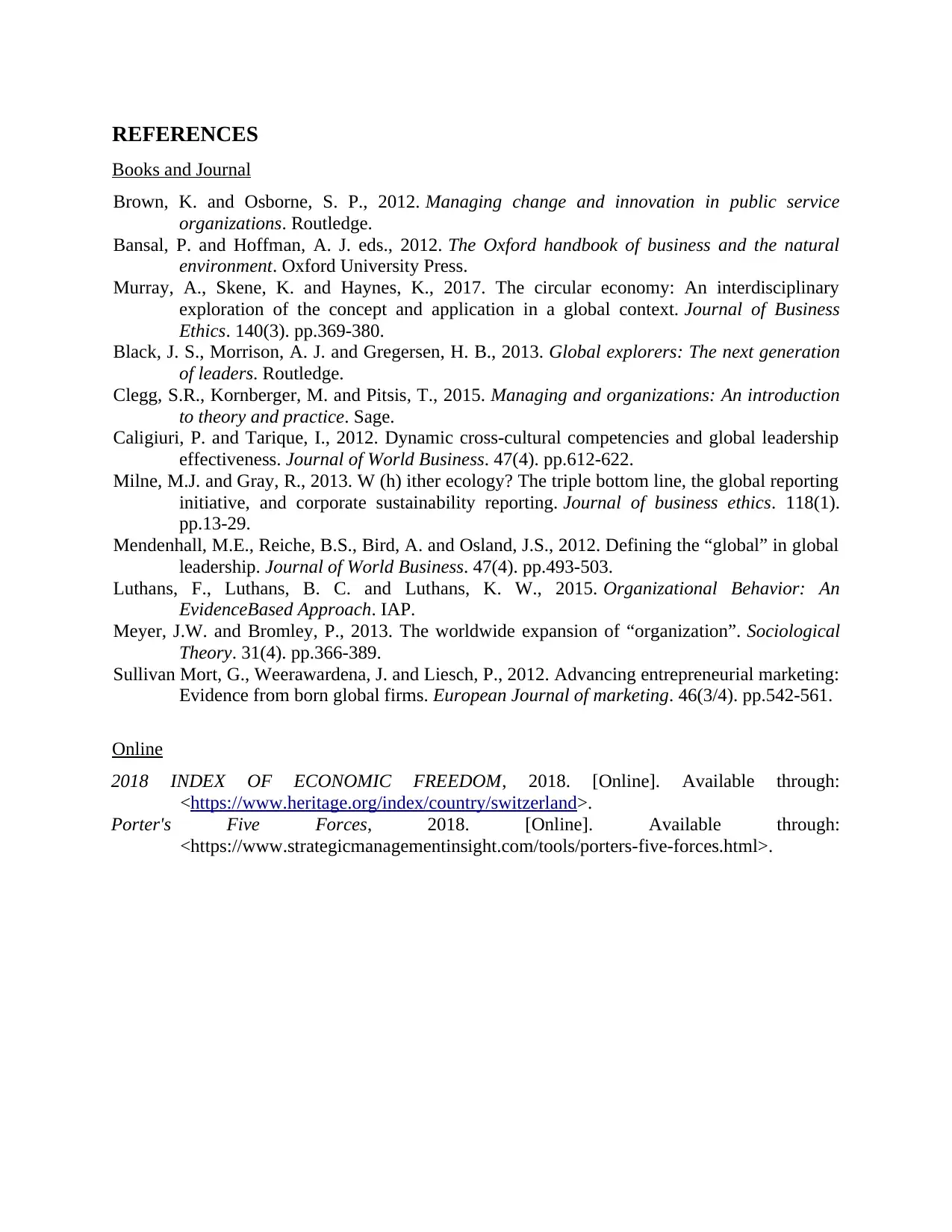
REFERENCES
Books and Journal
Brown, K. and Osborne, S. P., 2012. Managing change and innovation in public service
organizations. Routledge.
Bansal, P. and Hoffman, A. J. eds., 2012. The Oxford handbook of business and the natural
environment. Oxford University Press.
Murray, A., Skene, K. and Haynes, K., 2017. The circular economy: An interdisciplinary
exploration of the concept and application in a global context. Journal of Business
Ethics. 140(3). pp.369-380.
Black, J. S., Morrison, A. J. and Gregersen, H. B., 2013. Global explorers: The next generation
of leaders. Routledge.
Clegg, S.R., Kornberger, M. and Pitsis, T., 2015. Managing and organizations: An introduction
to theory and practice. Sage.
Caligiuri, P. and Tarique, I., 2012. Dynamic cross-cultural competencies and global leadership
effectiveness. Journal of World Business. 47(4). pp.612-622.
Milne, M.J. and Gray, R., 2013. W (h) ither ecology? The triple bottom line, the global reporting
initiative, and corporate sustainability reporting. Journal of business ethics. 118(1).
pp.13-29.
Mendenhall, M.E., Reiche, B.S., Bird, A. and Osland, J.S., 2012. Defining the “global” in global
leadership. Journal of World Business. 47(4). pp.493-503.
Luthans, F., Luthans, B. C. and Luthans, K. W., 2015. Organizational Behavior: An
EvidenceBased Approach. IAP.
Meyer, J.W. and Bromley, P., 2013. The worldwide expansion of “organization”. Sociological
Theory. 31(4). pp.366-389.
Sullivan Mort, G., Weerawardena, J. and Liesch, P., 2012. Advancing entrepreneurial marketing:
Evidence from born global firms. European Journal of marketing. 46(3/4). pp.542-561.
Online
2018 INDEX OF ECONOMIC FREEDOM, 2018. [Online]. Available through:
<https://www.heritage.org/index/country/switzerland>.
Porter's Five Forces, 2018. [Online]. Available through:
<https://www.strategicmanagementinsight.com/tools/porters-five-forces.html>.
Books and Journal
Brown, K. and Osborne, S. P., 2012. Managing change and innovation in public service
organizations. Routledge.
Bansal, P. and Hoffman, A. J. eds., 2012. The Oxford handbook of business and the natural
environment. Oxford University Press.
Murray, A., Skene, K. and Haynes, K., 2017. The circular economy: An interdisciplinary
exploration of the concept and application in a global context. Journal of Business
Ethics. 140(3). pp.369-380.
Black, J. S., Morrison, A. J. and Gregersen, H. B., 2013. Global explorers: The next generation
of leaders. Routledge.
Clegg, S.R., Kornberger, M. and Pitsis, T., 2015. Managing and organizations: An introduction
to theory and practice. Sage.
Caligiuri, P. and Tarique, I., 2012. Dynamic cross-cultural competencies and global leadership
effectiveness. Journal of World Business. 47(4). pp.612-622.
Milne, M.J. and Gray, R., 2013. W (h) ither ecology? The triple bottom line, the global reporting
initiative, and corporate sustainability reporting. Journal of business ethics. 118(1).
pp.13-29.
Mendenhall, M.E., Reiche, B.S., Bird, A. and Osland, J.S., 2012. Defining the “global” in global
leadership. Journal of World Business. 47(4). pp.493-503.
Luthans, F., Luthans, B. C. and Luthans, K. W., 2015. Organizational Behavior: An
EvidenceBased Approach. IAP.
Meyer, J.W. and Bromley, P., 2013. The worldwide expansion of “organization”. Sociological
Theory. 31(4). pp.366-389.
Sullivan Mort, G., Weerawardena, J. and Liesch, P., 2012. Advancing entrepreneurial marketing:
Evidence from born global firms. European Journal of marketing. 46(3/4). pp.542-561.
Online
2018 INDEX OF ECONOMIC FREEDOM, 2018. [Online]. Available through:
<https://www.heritage.org/index/country/switzerland>.
Porter's Five Forces, 2018. [Online]. Available through:
<https://www.strategicmanagementinsight.com/tools/porters-five-forces.html>.
1 out of 11
Related Documents
Your All-in-One AI-Powered Toolkit for Academic Success.
+13062052269
info@desklib.com
Available 24*7 on WhatsApp / Email
![[object Object]](/_next/static/media/star-bottom.7253800d.svg)
Unlock your academic potential
Copyright © 2020–2025 A2Z Services. All Rights Reserved. Developed and managed by ZUCOL.





